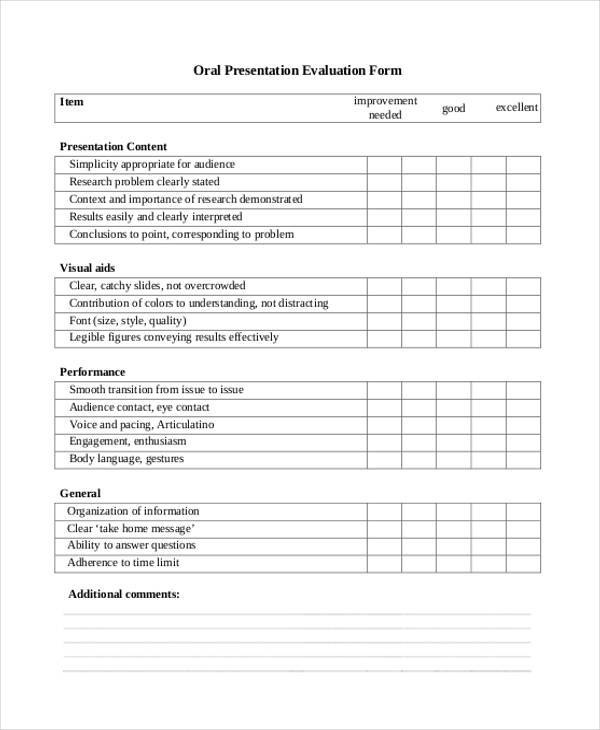Conducting an Evaluation of an Oral Presentation is not a very complicated thing to do; however, as a person tasked to evaluate an oral presentation, you have to be sure that you are able to take into account the different factors that make up a good and effective Oral Presentation to ensure that a presenter is able to provide the proper and accurate information based on the given subject.
Oral presentations can be used in both academic and professional fields. It can either be formal or informal, depending on the purpose of the oral presentation and the audience who are expected to listen to what will be presented. A presentation could be delivered in various ways, such as a lecture, an informative speech, a persuasive speech, or a demonstration. To identify whether a presentation or the presenter is effective, organizations can use an Evaluation Form to gather the comments of the audience.
Student Oral Presentation Evaluation Form
Formal Oral Presentation Evaluation Form Example
Oral Presentation Evaluation Form
Scoring Oral Presentation Evaluation Form
Elements of an Oral Presentation
When you are asked to critique an Oral Presentation, it is imperative that you know and understand the different elements that constitute an effective and well-delivered oral presentation which are clearly defined below:
Confidence
Delivering a speech in front of a lot of people can be an awkward and nerve-wrecking experience for some. One of the main challenges of presenting is to make your audience believe that you are not intimidated by them. Being able to present confidently in front is a sign that you know exactly what you are talking about and will convince your audience to believe in you.
Actions that illustrate confidence in a speaker include when he is able to maintain proper posture – head up or chin up – when he moves freely around the space given to him, when he is able to use an adequate amount of hand gestures, smiles, does not fidget, has an audible voice, makes eye contact, and speaks at a moderate pace.
Content
Content is king, or so they say. The details embodied in a presentation are what make sense of the reasons why he is there to begin with. When creating a speech, an entity needs to make sure that the content of what will be delivered during a program or any other gathering is both informative and relevant. Details must be identified, specified, and further elaborated when necessary. More so, the details that will support the topic of the presentation should be strong and evident.
Clarity
Aside from the content of the presentation, it is the clarity of the delivery that provides impact to the audience. It is important for a presenter to ensure that his/her delivery is smooth and understandable. Details should be mentioned in an organized manner and important information must be stressed out accordingly. All the key points to be presented must be stated in a moderate pace for retention of details be more possible.
If you are a teacher doing an evaluation on a student’s oral performance, you can also use our Student Evaluation Forms to help save you time.
Oral Presentation Evaluation Form Rubric Sample
Group Oral Presentation Evaluation Form
Oral Presentation Evaluation Form High School
Class Oral Presentation Evaluation Form Example
Structure
The structure of a presentation is important to make sure that the audience is able to understand its main idea. Ideas and supporting details have to be clearly and properly outlined, and the speaker should be able to transition from one point to another with the use transitioning phrases such as “first of all,” “and,” “and then.” A speaker should also be able to come up with an attractive and interesting introduction, a perfectly outlined body, and a memorable conclusion.
Visual Aids
One way to make a presentation interesting and engaging is with the use of visual aids. Commonly used visual aids are PowerPoint slides. PowerPoint is a Microsoft application that uses slides to present an outline of a topic. Presenters can provide the key notes and the summary of their topic through these slides so that the presenter and audience will be on the same page. Remember that your visual aids should only contain a summary or an outline and not your whole speech; this defeats the purpose of your presentation. If you want to, you can provide your audience with handouts containing your presentation so they can follow through even more. This will also allow them to review about the presentation even after the program has already ended.
Make sure to identify the strengths and weaknesses of presentations through the use of evaluation forms. May it be in the field of marketing, research, or any other professional undertakings; it is best for you to be aware of what makes a presentation great and how it can be further improved.
You can view our Presentation Evaluation Forms to help you properly document your evaluations. Proper documentation allows you to provide clear and accurate feedback.
Related Posts
-
FREE 7+ Sample Oral Presentation Evaluation Forms in PDF | MS Word
-
Presentation Evaluation Form
-
Internship Evaluation Form
-
Food Sensory Evaluation Form
-
Candidate Evaluation Form
-
Call Monitoring Evaluation Form
-
Chef Evaluation Form
-
Customer Service Evaluation Form
-
Mentee Evaluation Form
-
Speaker Evaluation Form
-
FREE 14+ Vehicle Evaluation Forms in PDF
-
FREE 14+ Trainee Evaluation Forms in MS Word | PDF
-
Resume Evaluation Form
-
Debate Evaluation Form
-
FREE 14+ Retreat Evaluation Forms in PDF








